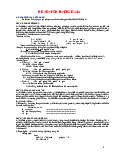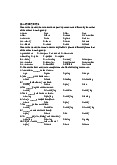



Preview text:
The charts below show the water levels of 6 cities in Australia in October 2009 and 2010.
Summarize the information by selecting and reporting the main features, and make comparisons where relevant.
The bar chart illustrates the changes in the levels of water in reservoirs across six
Australian urban areas between October 2009 and the same month in 2010.
Overall, the water level in Darwin decreased over the period in question,
whereas the opposite trend was witnessed in the other cities, except for Brisbane,
where no changes were recorded. Furthermore, Canberra was the city with the
highest percentage of water stored in its reservoir by the end of the period.
In October 2009, Sydney and Canberra had more water at their disposal than any
other city listed, as around 75% of their reservoir levels were filled.
These metropolises were followed by Brisbane, Darwin, and Perth, with their
figures ranging from 40% to nearly 60%. In the last position was Melbourne,
whose water reservoir was just over a fifth full.
After one year, the capital city took the lead, with its water level increasing to a
high of close to 100% of the total storage capacity. Sydney and Melbourne
followed similar trends, albeit at lower rates, rising to 80% and 40%, respectively.
The largest rise was seen in the proportion of water stored in Perth’s reservoir,
reaching approximately 70%. This contrasts starkly with the data for Darwin,
where a fall to roughly 25% was reported, and lastly, the figure for Brisbane stayed the same.
The graph below shows the average retirement age of males and females
in six countries in 2003. Summarise the information by selecting and
reporting the main features and make comparisons where relevant. Write at least 150 words.
The given table illustrates the average age men and women when
they retired in 6 countries namely: Australia, the USA, Japan, Italy, France and Korea in 2003.
Overall, it can be seen that Korea had the highest retirement age.
Furthermore, the average retirement age in all listed nations
witnessed an upward trend throughout the period shown.
Looking at the table for more detail, Australian and American males
retired at the average around 65 years while this figure figure for
females was approximately 64 years. The average retirement age of
men in Japan was 67 years and a third, which was more than 7
months of this figure for women in this nation. Besides, males and
females in Korea retired at the average age of 68 years and 8
months, and 67 years and 2 months, respectively.
Moving to Italy, while the average retirement age of men in Italy
was 58 years and 2 months, the statistics for women were less by
11 months. These figures for French males and females were the lowest at around 57 years.




